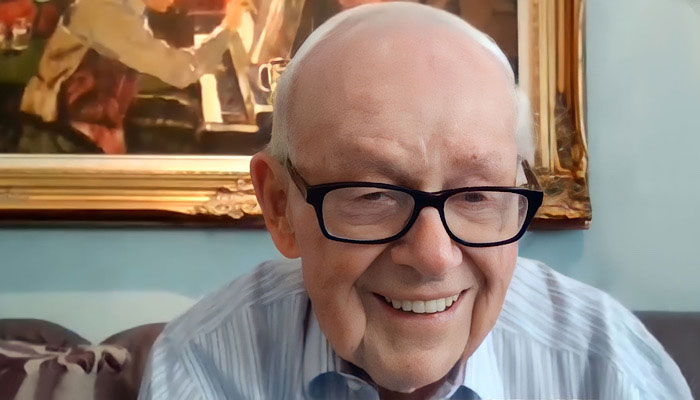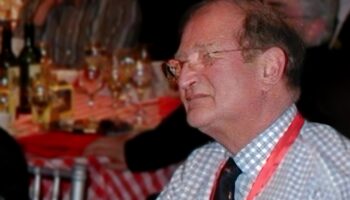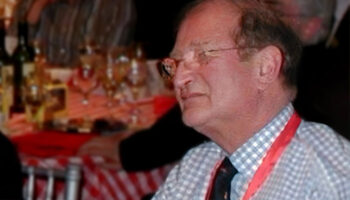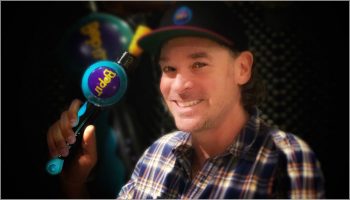Legendary inventor Eddy Goldfarb – the man behind toys like Chattering Teeth, Stompers and KerPlunk – on the power of optimism

Eddy, I’m over the moon to be chatting with you. A huge thanks for making time. To kick us off, what set you on the path to inventing?
When I was a little kid, my father brought an inventor round for dinner. He introduced us, saying “This is an inventor”. That’s when I learned what an inventor was and from then on, I always wanted to be an inventor. I always had ideas and that was my goal for the rest of my life.
When did that goal become a reality?
I got a little older and then the war started. I joined the navy and volunteered for submarine duty; I was in radar. I was serving on a submarine, the Batfish, and the war with Germany was over but we were still fighting Japan. I didn’t know about the atomic bomb or when the war would end, but I thought I’d better start making plans for what I’d do after the war.
After doing a lot of reading, I decided I needed to specialise. I needed an industry that was open to new ideas, so I decided I’d specialise in toys. I didn’t have much money either, so I needed an industry that could be cheap to invent for and toys fit the bill there too.
And you made that decision while you were still at sea?
Yes. I actually designed three toys while I was aboard the Batfish on my last war patrol. I came home with the three toys and managed made a model of one of them.
What sorts of toys were they?
They were educational items… I had no idea that – at the time – it was the sector the toy industry was least interested in!
Ha! So they were a tough sell?!
Well, I found a toy company in Chicago. I showed one of the ideas to the woman there and she said: “We’ll take it”. It felt so easy – the first person I’d shown a toy to had wanted it! I then showed her the other two and she said “No, I just want the first one”. I said “No, you’ve got to take all three”. She said: “No, I just want one”. So anyway, there’s three items still available…
Hahaha! And what was the item she said yes to?
It was a toy where you had four pictures in a row, and there were four name tags to match the pictures, but they were all mixed up. So if you wanted to match the dog, you had to find the tag that said ‘Dog’ and put it under the dog. It was a very simple game – it wasn’t electronic or anything like that.
In the brilliant Eddy’s World documentary, you say “I annoy people with my optimism”. Is optimism a vital trait for any inventor?
Absolutely. I’ve told people over the years who want to invent that you’ve got to learn to love rejection because you’ll get so much of it. Rejection always disappointed me, of course, but it didn’t bother me that much.
Was there anything that connected all your ideas? A trait that typified an ‘Eddy Goldfarb’ invention?
No, thank goodness! I don’t think there was a relationship between any of the items I made. Each one was very different. I’ve invented toys, games, dolls… There was never a shortage of ideas. I wanted to make money! I wanted the royalties to come in!
Of course! And how did you have ideas Eddy? Where did you find inspiration?
I have no idea where they came from really. I could be looking at something and an idea would just come to me. For example, the Chattering Teeth. I saw an ad in the paper for a ‘Tooth Garage’. Being young and foolish, I didn’t realise what it was until I studied it and realised that people had false teeth. I thought that was very funny at the time, but now I know about it all too well!
But I wanted to invent something around false teeth, so I went to my dentist and got a set of false teeth. I wanted the teeth to come alive; I wanted them to start moving, so I found a wind-up motor and put it together with the teeth.
I used Marvin Glass as an agent for that item. I met him after the war, I showed him the teeth and he loved it. He knew Irving Fishlove of H. Fishlove & Co – I had no idea who Irving Fishlove was. But Irving bought it immediately.

And what a smash it turned out to be.
Yes… And I’ll say, Marvin didn’t exactly cheat me, but he wasn’t exactly fair either.
Oh really?
I got $900 for it. Irving Fisher bought the item outright for $25,000. Marvin never admitted it but we made a terrible mistake selling it outright. That was the last item I ever sold outright. But I got enough money from Chattering Teeth to buy an overcoat – and Chicago was cold!
There’s that optimism again! What a story. And did your dentist ever know that he played a small part in the creation of a toy icon?!
I have no idea. I was afraid of him – I never went back!
Haha! Now, moving onto one of your other classics – KerPlunk! How did that come about?
Well, I started hiring people as soon as I could. This guy came to me and said that he wanted to make toys, so I hired him. His name was Rene Soriano. He was a wonderful guy. He came up with this idea, we liked it and so we built a model. I showed it to Lionel Weintraub, the president of Ideal Toy Company, and he bought it immediately.

You mention Lionel, and you had a great relationship with Ideal over the years.
Yes. Well you see, very early on and with no real money, I went to the hobby show in Chicago. I didn’t know any of the toy companies well, and they wouldn’t let me in because I was an inventor – they only wanted buyers at the show. I’d spent so much money to get there that I didn’t have enough to get home, so I wasn’t just going to leave!
I walked around the building, found a door and went inside. I soon realised I was standing round the back of the displays. I kept walking until I found what I thought was a door… I pushed on it hard enough to knock down the display of Ideal Toy Company.
Haha! What did you do next!?
I climbed through the display and ran! Then I thought ‘That’s not nice, I can’t do this’. So I went back and apologised. They said: “Don’t worry, we’ve managed to get the display back up. Come and see us!” That was my introduction to Ideal Toy Company! I ended up placing over 50 items with them and became very close friends with the people there.
Eddy, we’ve spoken about rejection and we’ve spoken about some of your biggest hits, but did many of your most iconic creations get turned down?
Yes – some of my biggest items were turned down by the world’s biggest toy companies.
For example, Stompers. Stompers was turned down by Mattel and Ideal. Then Bill Garrity – who had just become president of Schaper Toys – called me. Schaper Toys was going bankrupt and so they brought in Bill, who was a banker, to try and save the company. He needed ideas so he called me and then he came in.
He came at a very opportune time because I’d actually placed Stompers with Kenner Toys, but they returned it to me. A few days later Bill Garrity came in, I showed him the item and he liked it very much. He’d laid off most of his staff at the time but I had a wonderful team, so we came in and did all of the design work. I had a wonderful designer called Del Everitt who was integral. He’d worked in Detroit and was a car bug.

And for anyone unfamiliar with Stompers, they were little battery-powered toy cars?
Yes, and the thing with Stompers is that they didn’t look exactly like real vehicles – they were a little rougher and tougher, the wheels were a little larger… It turned out to be a tremendous item and it saved Schaper Toys. Bill Garrity became a hero and it was the start of a wonderful relationship.
When you’d get rejection after rejection, how did you gauge whether an idea was worth sticking with?
Well, a nice example for this is the Bubble Gun. I made this beautiful Bubble Gun and it really was a nice model. You’d put it in a dish of soapy water and this motorised gun would then blow bubbles. I went to Mattel first as I had a wonderful relationship with them. They said: “Eddy, why would anyone pay $5 for bubble gun when they can buy a bottle of bubble fluid for 39 cents. It comes with a wand inside and you can blow bubbles with that!” Then I went to Hasbro and they said exactly the same thing! This happened right down the line, so I put the Bubble Gun back in the closet.
Then one day, John Osher came to see me. I’d given John his first big item – the Electronic Arcade Basketball – and he’d come back for his second item. He came with his girlfriend Bonnie and I showed them the Bubble Gun – and he said the same thing! “Why would anyone buy this gun?!” Then Bonnie said: “John, you’re going to make that item!” He said: “No I’m not, it’s going to cost me money to make that item”. She said: “John, you’re going to make that item!” They weren’t married yet! Anyway, she won that argument and he made the Bubble Gun. It turned out to be a huge success.

I imagine you insisted he bring Bonnie to every meeting from that point on! Did having these big hits make pitching easier?
Oh yes. Successful toy inventors didn’t have to go far because the toy companies would come to you. They don’t want to miss out on a good item. If you invent a toy, put time into it and make a decent model, you’ll make an impression with the toy companies and they’ll remember you. And if they remember you, there’s a good chance they’ll come back to find out what else you have.
I also wanted to ask about comradery in the inventing community. Did you enjoy the unique friendships that form between what, in other industries, might be perceived as fierce rivals?
Absolutely. Some of my best friends were toy inventors, like Tom Kremer of Seven Towns. I went to his home, he came to see me in LA. I was also friends with people at toy companies too, like Torquil Norman. We were always close. I respected them, they respected me and we always had a nice relationship.
Lovely. Now, as well as a legendary toy inventor, you’re also a winner of the prestigious I.D.I.O.T. award, given out at the annual Toy Inventors’ Dinner. What did winning that mean to you?
I was honoured. I was the first American to win the award and I was very proud of that. And I had a wonderful relationship with lots of UK inventors.

Going back to the documentary – in it you describe the toy industry as “a noble industry”. Could you tell us a bit about what makes it a noble sector?
Because it deals with children at a very young age and helps mold their lives. One of the noblest of occupations is that of a teacher. They help children get started in life and toys are a teaching tool really. They’re very important to a child’s life, so I think we make a good impression on the world.
The documentary also touches on the friendships you’ve made at your retirement community. Is it quite fun meeting new people and explaining you’re not only a toy inventor, but you’re actually responsible for some truly iconic products?
It’s a big retirement community, there’s around 500 people here, and with everyone you meet, one of the first things you talk about is your background. “What did you do? Is this your second marriage? Or your third? Or your first?” People are always interested to know that I invented toys, and most of the time they’d know them. Some of them have even played with toys that I’ve invented – I’m older than most people here! I think I’m the oldest one in California!
On that, you’ll be 102 in September. Do you think a career in toys has played a part in your long life, or do you just have good genes?
Of course, you’ve got to be lucky – I went through the war safely. But I think doing creative work of any kind is healthy for you. It could be knitting socks for a baby… If you start with nothing and end with something, I think that process is good for you.
Eddy, this has been a joy. A huge thanks again for taking time out for this. I really appreciate it.
–
To stay in the loop with the latest news, interviews and features from the world of toy and game design, sign up to our weekly newsletter here

























